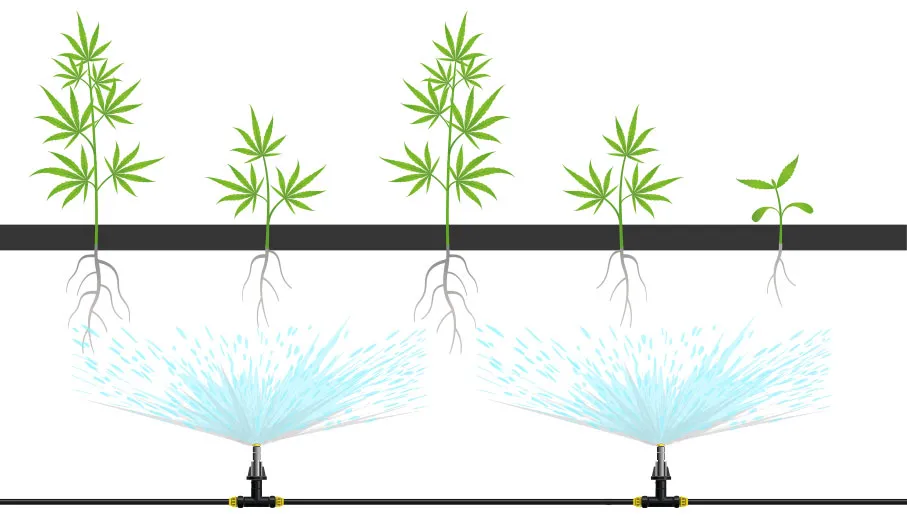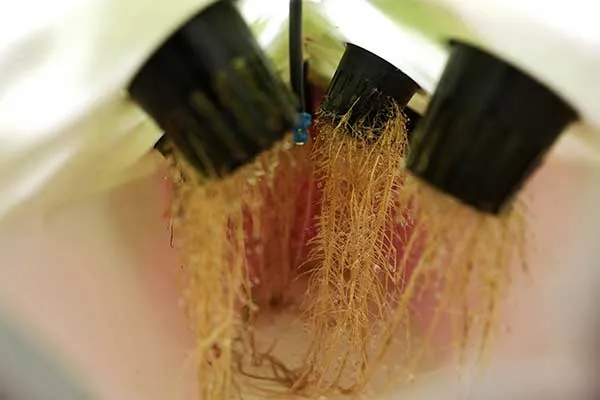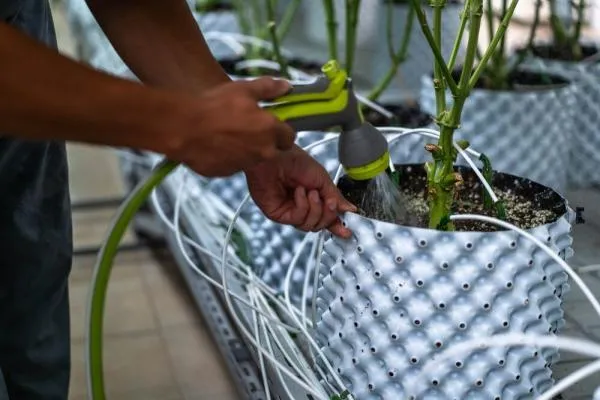Aeroponics is a cannabis cultivation technique that involves suspending the plant's so that their roots dangle down in a chamber where they are sprayed with a nutrient solution. This provides them with plenty of oxygen and nutrients and allows them to grow without the need for soil. Aeroponics is an excellent alternative to traditional soil growing because it uses less water and produces big yields in a short space of time. But is it better than other traditional hydroponic methods such as DWC and NFT? Let's take a look at how they compare....
How does aeroponics work?
Aeroponics works in a similar way to hydroponics, what is different is the way in which the water is delivered to the plant. The plants grow above a chamber with their roots hanging down where they are suspended in the air and sprayed with a nutrient-rich mist. This solution is a mix of water, nutrients, and minerals, that is delivered through misting nozzles from a reservoir situated below the plants.
There are two main components in an aeroponics system: the reservoir, and the planter bed. The reservoir stores the water supply. It is also where growers can test the nutrient levels of the water.
The planter bed is where the plants will sit as they grow. The planter bed supports the plants, and slightly separates the root from the plant. This helps prevent mold and rot to the stem. Planter beds must include a misting system and a drainage system. Aeroponics rely heavily on moisture. If the water is not properly administered and drained, it could wreak havoc on a crop.
Lastly, the setup requires pumps that will transfer the water from the reservoir to the misting system.
At its most basic, aeroponics is the use of continual mist. This mist, not a growing medium, feeds the plants and provides them with the exact amount of water and nutrients necessary. The mist sprays the roots constantly, making sure they are always damp. Any excess water that drains off the roots falls into a tray and is pumped back into the reservoir to be reused.

What are the pros and cons of growing weed using aeroponics?
Aeroponics has become known as a revolutionary method of growing due to the number of benefits it holds.
Pros of aeroponics:
Efficient & envornmentally friendly: Highly efficient use of water and nutrients, reducing waste and promoting sustainability. Aeroponics setups are also known for being one of the most environmental ways to grow. They take up less space, which means more plants can be grown. This is good for the grower short on room, but also good for the planet. More plants means more CO2 is removed from the environment, and more oxygen is put back into it. Aeroponics systems have also received praise for the limited amount of water they use, further lessening the harmful impact of growing on the environment.
Faster growth: Efficient nutrient delivery and an abundance of oxygen means that weed grown with aeroponics grows faster and larger yields compared to traditional soil-based growing methods and some other hydro systems.
Healthier: Plants grown aeroponically are generally healthier and more resistant to pests and diseases. The roots of a marijuana plant flourish when exposed to oxygen. With this type of system, those roots are constantly getting all the oxygen they need.
Space efficient: Aeroponic systems can be designed to be highly space-efficient, making them suitable for urban or indoor farming.
Cons of aeroponics:
Complex: Aeroponics systems are high-tech which is why they’re considered to be so revolutionary, but also one of their biggest disadvantages. These systems are highly controlled, and require a great deal of know-how before serious results are seen. For this reason, this method can be quite challenging for beginners.
Cost: Aeroponic systems can be complex and expensive to set up and maintain, requiring specialized equipment and knowledge.
Power outages and break downs: Power outages or other disruptions to the system's air or water supply can wreak havoc on your grow. Remember unlike hydro systems such as DWC, wick and drip irrigation, the roots with hydroponic systems are suspended in air, so if the power cuts, no water will be sprayed on the plant. This could kill the plants within a matter of hours. Power outages aren’t the only thing that can go wrong in an aeroponics system, either. Nozzles can become clogged, pumps can break, and reservoirs can become completely empty.
Is aeroponic weed better?
If anything, aeroponics systems are known for being extremely beneficial for the plant when set up properly. Due to this, when this method is used to grow marijuana, it’s a superior product. The roots remain strong during the entire growth period, which allows the plant to flourish and thrive, and develop large healthy buds covered in trichomes.
In addition to the buds being substantial, there are also typically more of them in aeroponics systems. Growers using this method will see many more buds than they would in soil. This is a result of not only the setup, but also the fact that the weed has been grown indoors.
The only area in which the quality of marijuana grown in aeroponics and all hydroponics systems is negatively affected, is the flavor profile of the cannabis. Soil can provide a rich array of tastes and smells, and these are often not as present in aeroponics systems.
How Often Do You Water Aeroponics?
The frequency of watering in an aeroponic system depends on several factors, including the type of plants being grown, the size of the system, and the environmental conditions. In general, plants grown aeroponically require more frequent watering than those grown in soil or hydroponic systems. This is because the roots are exposed to the air, which can cause them to dry out quickly. Most aeroponic systems are set to water the plants every few minutes, which keeps the roots consistently moist.
Is aeroponics better than hydroponics?
Aeroponics and hydroponics are both great methods for growing weed without soil, but they do have some differences that may make one more suitable than the other.
The main advantage that aeroponics has over hydroponics is that it allows for better oxygenation of the roots. With hydroponics, the roots are normally submerged in water, which can lead to oxygen deprivation. Whereas with aeroponics, the roots are exposed to air, which allows for more efficient oxygen uptake and prevents root rot.
On the other hand, hydroponics can be easier to set up and maintain than aeroponics. Hydroponic systems are generally more established in the market, and there are more resources available for beginners. Systems such as DWC are excellent for beginners, whereas aeroponics may be a little bit to advanced for a novice grower.
Ultimately, the choice between aeroponics and hydroponics depends on the size of the growing space, your skill level as a grower and what you want from your plants. Both methods have their advantages and disadvantages, and choosing the right one will depend on your specific needs and preferences.










